A Euro-Style Rail Trip in North America
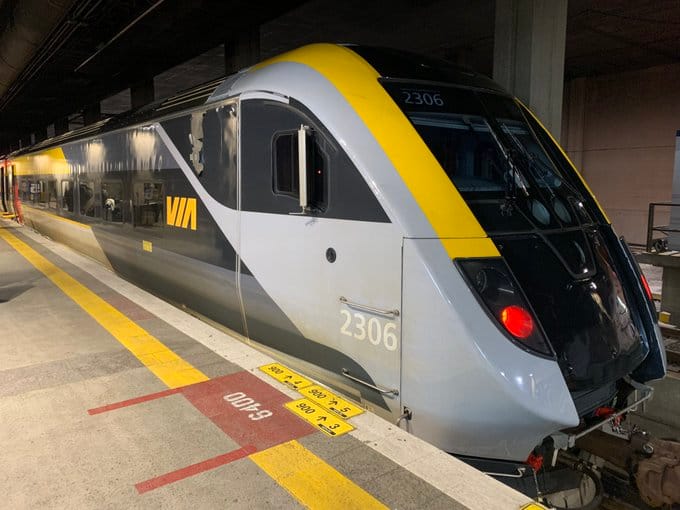
Quebec City to Montreal on Via Rail's High-Speed-Lite Train: A Review
// I was invited to a book festival in Quebec City this month, and, when the organizers asked me how I wanted to get there from Montreal, I said: By train, bien sûr!
The distance between the province of Quebec's two largest cities is 269 kilometers, or 167 miles. Driving takes three hours if you go by the (more attractive) highway on the north shore of the St. Lawrence River, slightly less if you take the Trans-Canada Highway south of the river. The latter is a near featureless run through sprawl and a die-flat landscape. Soul-sucking, especially on a grey day in the Canadian spring. At least on the train you can kick back and get some work done (under-achieving Wi-Fi permitting, of course).
The night before my departure, I got an email about a change to my assigned seat, which I knew meant one thing: a change of equipment. My heart sank when I took the stairs down to the platform from downtown Montreal's Gare Centrale. I'd be riding in a LRC economy car, the ugly duckling of the Via Rail fleet.
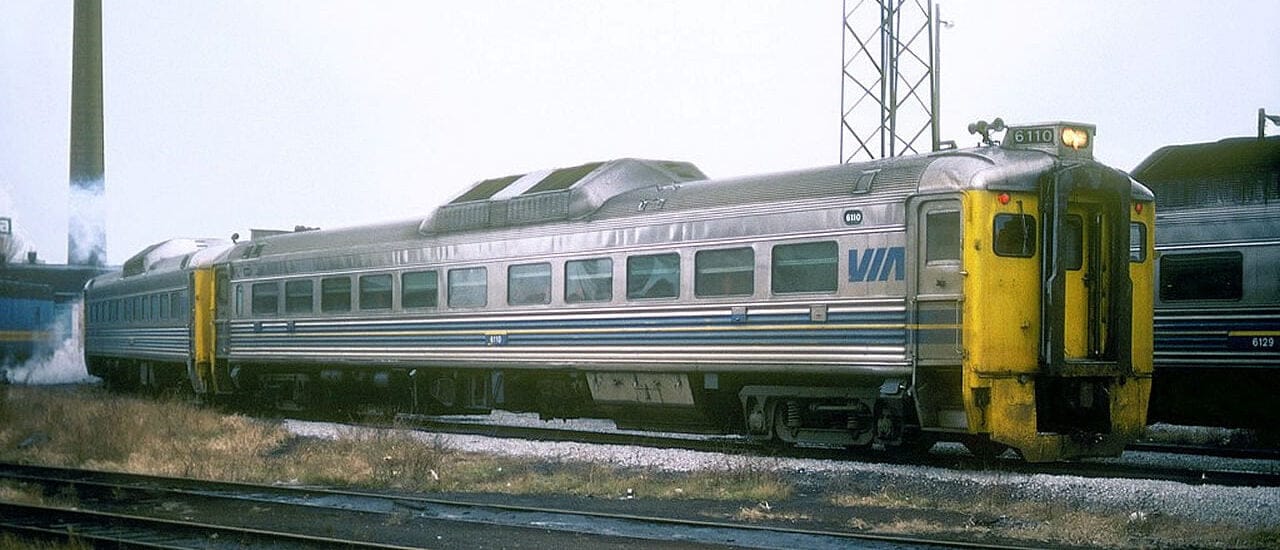
Canada's national rail service boasts some comically antiquated passenger cars . Friends who have come from Europe, the continent of high-speed, are prone to lengthy exclamations, many of them sarcastic, about the clanking rattletraps that ride the Canadian rails. I'm actually quite happy when I'm assigned a seat on a stainless-steel, streamlined RDC-1 car (for "Rail Diesel Car"), or better yet, an Economy Class Car. Both were built by the Budd Car Company, and picked up second-hand from Amtrak; the former were built in the mid-1950s, while the latter goes back, believe it or not, to just after the end of World War II. I'm not exaggerating—some were built in 1946: you can check out the specs here. They are beyond retro. They are living fossils.
Since I have a soft spot for the glory days of North American rail construction, I tend to get into the spirit of the thing, and pretend I've time-travelled back to the days of Pullmans, porters, and cocktail cars.
But the car I did get—and the one most people get when they do the Montreal-to- Toronto run—was the 1980s-vintage LRC Economy Car, an early effort by Bombardier. It's a car that is nobody's idea of glamour. Greyhound-level upholstery and lighting; noisy, shaky, and narrow. When I asked the conductor on the platform about whether there were new trains on the Montreal-Quebec City run, he replied, "Yes, but there was a substitution today. You'll be on one of the old ones."
I made the best of a disappointing ride. We pulled out of the Gare, threading our way past the high rises of Griffintown, and beneath the tracks of the REM, Montreal's new elevated, electrified light rail. We left right on time, at 8:36 AM, but—as I've come to expect with Via Rail—arrived late, at five to noon. No surprises there: delays are so predictable in this corridor, that I now reflexively tack on 20 minutes to every voyage I take.
It is nice to arrive by train in Quebec City, which has a palace-style station, with turrets to match the Château Frontenac without, and dignified brickwork within. (Go through some swinging doors, though, and the ambience changes abruptly: suddenly you're in the inter-city bus terminal, all linoleum, fluorescent lights, and the smell of drip coffee overheating on burners.) I spent a great weekend in Quebec City, which I'll write more about in next week's dispatch about the transport options in the, er, "national capital."
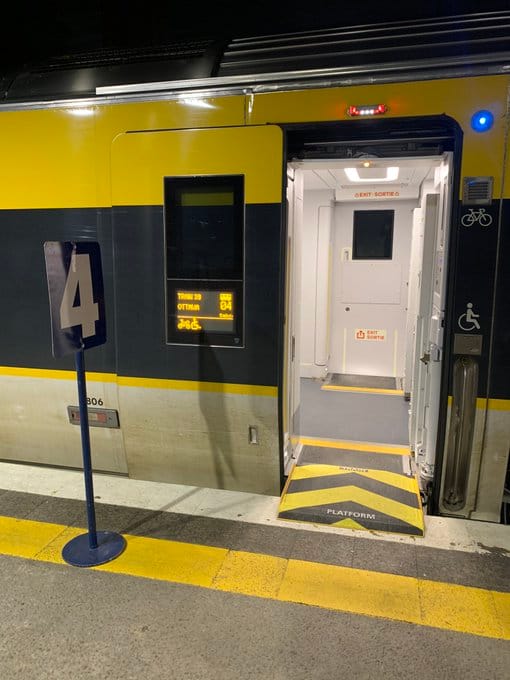
My return trip to Montreal was scheduled for 3 pm on a Saturday. I went through the familiar process of lining up before the entrance to the platform area, and showing the boarding pass on my phone to an attendant. This is the way they do things on Amtrak and Via Rail—airplane boarding style—and it's idiotic. (At stations in most major European cities, you scan your ticket at automated gates, and then proceed to the platform, where you wait for the train to arrive or board at your leisure if it's already in the station.)
This time around, I scored. The newest train in Via Rail's fleet was waiting on the platform: the kind of slant profiled, high-speed train I've gotten used to riding in Europe and Asia. A Siemens Charger locomotive, to be exact, with business and economy cars (branded by the German multinational as "Venture") and a cab car identical to the locomotive at the other end, which allows the train to reverse direction without going through complicated, time-consuming track changes. Via Rail has purchased 32 of these trainsets (locomotive-passenger-car combos), which now run in the Quebec City-Windsor corridor (with its northern spike to the other national capital, Ottawa).
First impression: they look pretty good. A yellow-light-grey-and-I'm-gonna-say-charcoal livery. Exterior screens next to the sliding doors indicating the final destination, and car number (which in theory allows passengers to board without having an attendant on the platform to guide them. Just like grown-ups!).
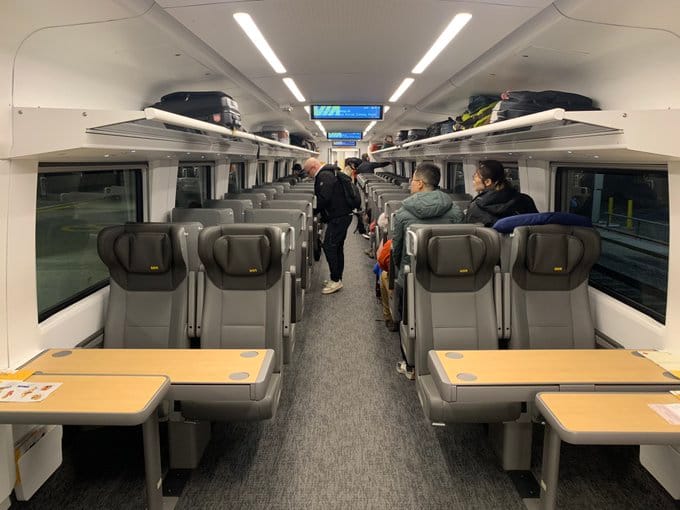
Inside: astonishingly spacious. The aisles are a half foot wider than in the LRC cars, and there's a really generous area for storing luggage when you enter. Same configuration as on other trains—2 seats, aisle, 2 seats—but the seats aren't the heavy, blocky, "richly" upholstered ones you get on the LRCs. More like airplane-style, with a smooth, leatheresque surface, and a good recline.
I boarded ten minutes before departure, and we pulled out, without fanfare, at the stroke of three. The slow exit from Quebec City was also a noticeably smooth exit: less of the rocking and rolling I'm used to on older Via Rail trains. A sensation of dépaysment: leaving the picturesque centre of Quebec City (which somehow feels like St-Malo, or another fortified town in western France) passing by strip malls, parking lots, big box stores—I'm obviously in North America, so what am I doing on a European bullet train? I felt the same thing when the new Alstom metro trains came to my hometown métro: a sense of temporal disorientation as the up-to-the-minute 21st-century trains slid through Montreal's 60-year-old, go-go-mod, pop-art-mosaic-filled stations.
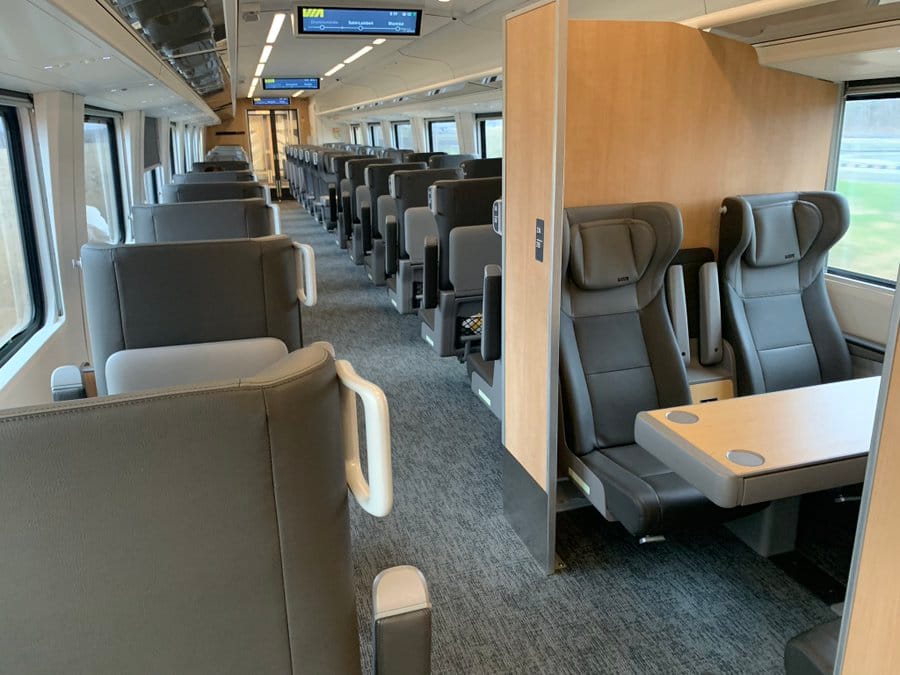
After settling in, I took a stroll, through a sealed gangway, to business class, located behind the front locomotive. Same decor as in economy, but with wider seats, in a 1-seat-aisle-2-seat configuration (aka "three across"). It also featured a "privacy pod," a partitioned-off roomette, presumably to allow executives to get together to discuss ways to pad their invoices without being overheard. Not on that day, though: there was a single passenger in the entire car. The chief advantage of riding business in Canada, in my experience, is the roving drinks cart. Unlimited booze, and boy, do some people take advantage. I've watched Ottawa bureaucrats consuming liters of Bloody Caesars—a Via Rail specialty—starting at 11 in the morning. (Your tax dollars at work, eh?)
The bathrooms. Huge. As I noted on social media, enough room to swing a bobcat. Futuristic, button-operated curving door. Along with the wide aisles, and on-platform elevators, this makes these trains wheelchair/mobility-device accessible, which is a truly great feature. As are the stations for filling your bottle with filtered water (I'm so done with plastic).
As we left St. Lambert, I was already thinking about future trips. Like, given the amount of space in the luggage area (and the little illuminated bicycle logo on the exterior screen), surely I could bring a bicycle on board. Ideal for a car-free family trip—getting off at Drummondville, and striking out with our bikes from there. Alas, when I asked the attendant, she told me bicycles weren't permitted on board yet. Check again in a month, she said: there might be a way to reserve space by the summer. Grrrrrrrr. Multi-modal travel, which is dead simple in most of western Europe, is still a struggle on this continent.
Now, I'll cut to the chase: our velocity. The bad news: still pretty slow, for most of the trip. The fatal flaw of Via passenger rail is that it still shares the tracks with freight trains. (I've kvetched about this here. Not to mention here.) Heavy, heavy, ridiculously long freight trains, which not only cause delays, but also distort the tracks and rail beds, making true high-speed travel for passenger trains that also use them unsafe. High-speed rail is best when it runs straight and flat: the route we were on was flat enough, but the route, via Drummondville, is still pretty curvaceous.
As I've written before, the only high-speed north of the Rio Grande is the Acela, in the northeast corridor between Boston and Philadelphia, and even that tops out at just 240 km/h (150 mph), well short of the 300 km/h standard in Europe and Asia. The Brightline, the privately-run line between Miami and West Palm Beach, looks fast, but tops out at 80 mph (128 km/h). The California high speed rail, which might eventually link San Diego to San Francisco and Sacramento, won't be running until at least 2030. The fastest train on the horizon is the privately-run Texas Central, which would run shinkansen (real Japanese bullet trains) between Houston and Dallas. That I hope to live to see. (But I won't be surprised if I don't.)
So, in some stretches, especially paralleling the Trans-Canada east of Montreal, we reached respectable—as in, see-you-later-car-drivers—speeds. The highest the figure on the overhead LCD screen (another feature familiar to me from European trips) reached was 155 km/h (96 mph). At this point, the top speed these Siemens trains are allowed to reach is 160 km/h, though their top speed is a respectable, if hardly world-beating, 201 km/h.
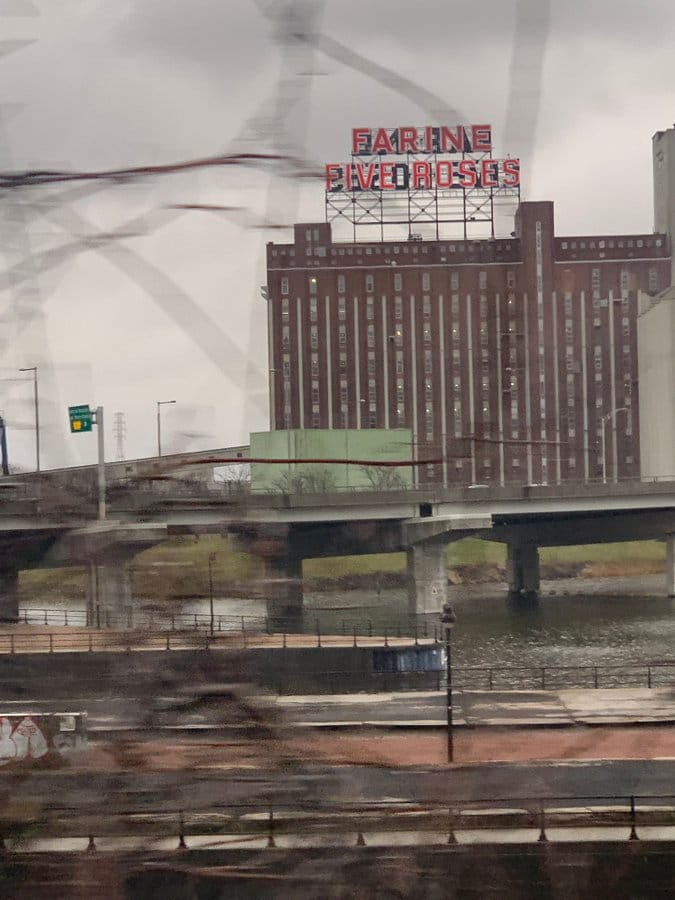
All that said, it was a thrill to be reaching TGV velocities on Canadian rails. And, for the first time in I can't remember how long, Via Rail got me to the destination right on time. I saw the FARINE FIVE ROSES neon sign along the Lachine Canal, the signal that I was almost home, and, to my shock, saw that we were pulling into the Gare Centrale exactly 3 hours and 11 minutes after we'd left. An average speed of 85 km/h (53 mph). Still far from Euro-norms, but the best I'd experienced in a long time. I rolled my bag off the train, caught the metro, and was back home, rested and relaxed, 35 minutes later.
These Siemens trainsets are already running on several Amtrak routes in the US. (Scroll down the page in the link for a list.) And the latest is that they'll be running on the soon-to-be-revived Ontario Northlander route out of Toronto's Union Station, up to once a day, which will be a boon for Timmins and other communities in the northern part of that province.
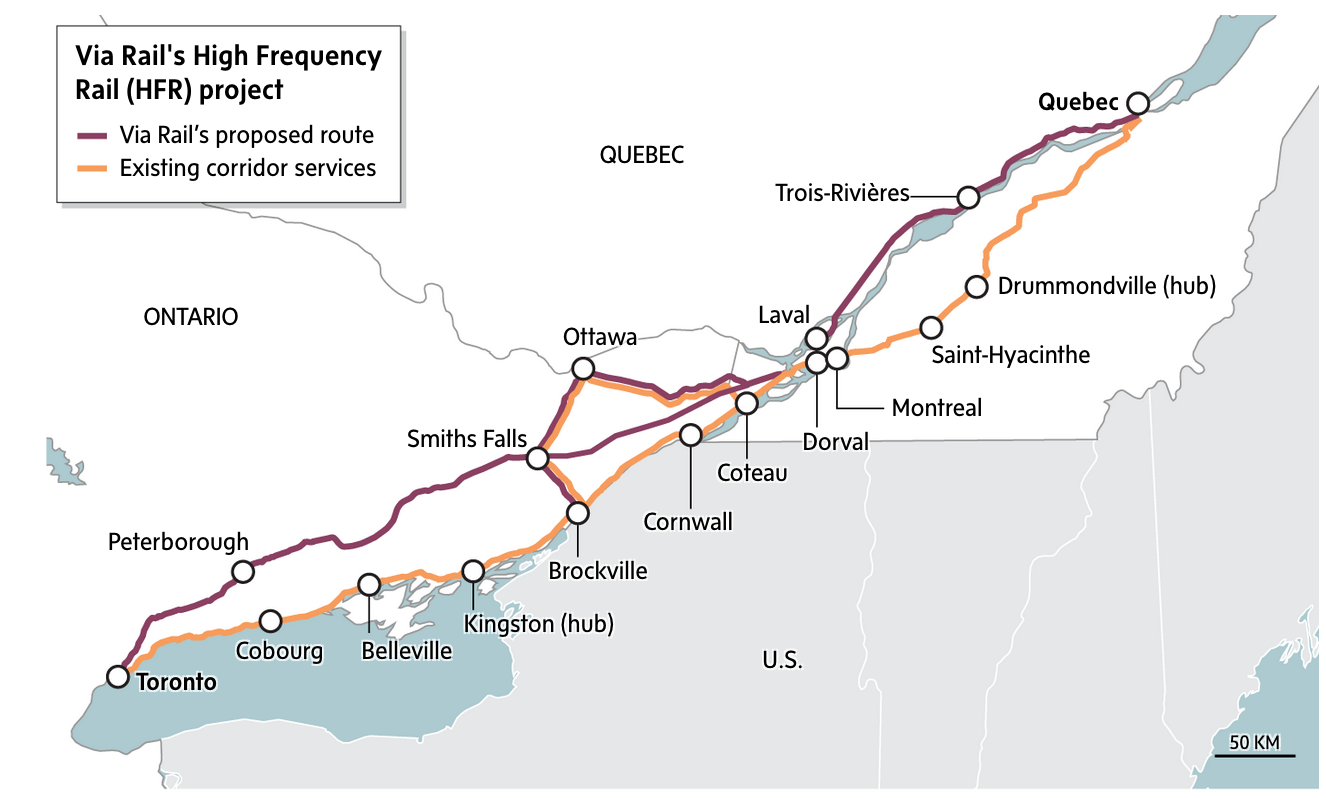
Now that we have the high-speed trainsets, we need true high-speed, especially on the Windsor-Quebec City corridor, whose catchment includes over half of Canada's population. Hearteningly, the latest news is we may get it. The discussion has moved on from HFR—high frequency rail—and electrification (the Siemens locomotives still run on diesel, though they can be converted to overhead wire) to electrification, high frequency and high speed. On the Quebec City to Montreal leg, that may involve a new route to run on the north shore of the St. Lawrence River, serving the much bigger centres of Laval (pop 44o,000) and Trois-Rivières (137,000).
It can't come soon enough for this straphanger.
